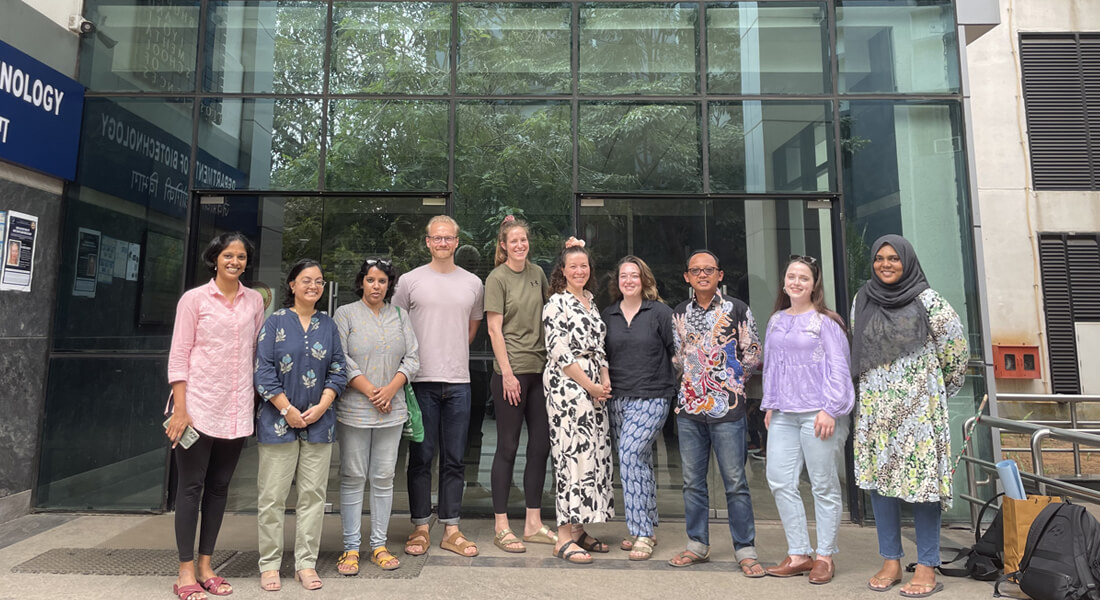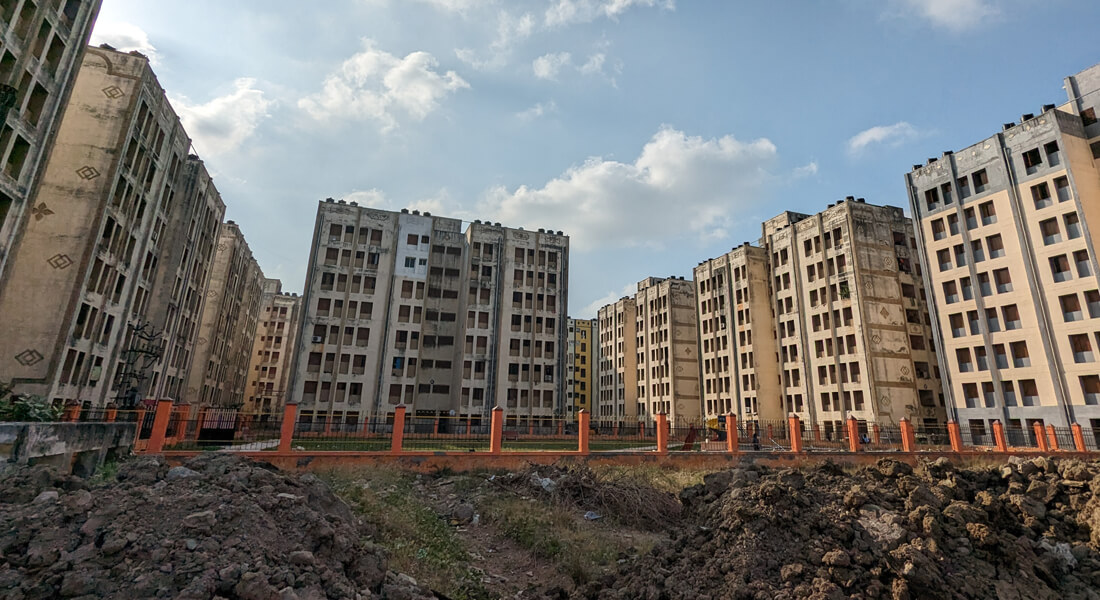Student experience in the Vulnerability and Risk Assessment Methods course, Chennai 2024
Supported and guided by community facilitators, Tamil interpreters, and our course instructors, we set out in two research teams to employ various investigative methods—such as semi-structured interviews, seasonal calendars, and transect walks—to closely examine both the physical environment of the resettlement area and the multidimensional experiences of its inhabitants. Over the week in the field, we engaged more than 70 participants in Perumbakkam through a range of EVCA tools. Talking to a tailor, a fish seller, and a group of neighbours each brought insight into how debt is accumulated with disasters, how heat affects living wages, and how floods affect children’s safety, respectively.

| This story was written by Julia Egger, Madeline Ewbank, Martin Hansen, Katrine Jaquet Mavraganis, Louisa Paustian-Bulmer and Yoshua Ade Nugroho. |
As part of the Master of Disaster Management programme, this year’s Vulnerability and Risk Assessment Methods (VRAM) elective was hosted in Chennai, Tamil Nadu, India in partnership with the Indian Institute of Technology Madras (IITM) School of Sustainability and Okapi Research and Advisory.
The course consisted of a week of theory-based lectures, a week of fieldwork, and a week of organisational visits to area disaster risk reduction (DRR) stakeholders and experts. For the fieldwork component, students utilised methods from the IFRC Enhanced Vulnerability and Capacity Assessment (EVCA) toolkit to analyse flood and heat-related disaster risk in Perumbakkam, a resettlement colony on the outskirts of Chennai, with guidance from COPE Director Emmanuel Raju and PhD Fellow Suchismita Goswami. The course was also situated within the DFF funded project on Disaster Risk Creation in Urban Resettlement Processes which is led by Assoc. Prof. Emmanuel Raju.
In this year’s VRAM cohort, we were six students from all different professional backgrounds ranging across insurance, security, medicine, meteorology, refugee support services, and INGO administration. The course offered a possibility to put theory into practice but also presented an opportunity to learn through interdisciplinary teamwork.
Several months prior to our arrival in Chennai, India, the area had experienced a major flooding event in December 2023 following the passage of Cyclone Michaung. Flooding and waterlogging pose a persistent disaster risk for the city, whose vulnerability is shaped by a multitude of factors, including coastal hazards, colonial history, rapid urbanisation, and poor water management. As part and parcel of local flood risk reduction strategy, there have been government efforts to relocate informal settlements from along Chennai’s waterways into “resettlement colonies” around the city and its periphery. These en-masse evictions of urban poor communities are conducted with the expressed intention to shield people from disasters and rehabilitate water bodies. However this resettlement narrative, which emphasises the safety offered by the towering concrete apartment buildings of the colonies, functionally serves to expropriate waterfront land for high-income real estate development and overlooks vital social and human elements critical to the wellbeing of resettled populations, including access to jobs, education, and social infrastructure.

| Above: Ewbank (2024) High-rise concrete apartment buildings of the Perumbakkam resettlement colony. |
Roughly 25 km south of the city centre, the resettlement colony of Perumbakkam was especially impacted by the 2023 floods and subsequent waterlogging. It is additionally vulnerable to a range of other hazards disrupting infrastructure and daily life, as well as presenting serious health and safety risks. Among these, we chose to focus on both flood risk and heatwave risk in our VCA, the latter being a hazard that is critically understudied outside of high-income countries and projected to be severe in Chennai due to the city’s overstretched water resources and high humidity. The intense heat of Chennai's summers already puts a significant strain on water and electricity infrastructure, a challenge played down by a common refrain we heard repeated by many throughout our three weeks of the course: “Chennai has three seasons— hot, hotter, hottest.”
Grasping the full scope of disaster risks in Chennai’s resettlement colonies necessitates a deep dive into the vulnerabilities and capacities of these communities, which we endeavoured to achieve during the three weeks of the VRAM elective. This involved employing EVCA tools to identify underlying issues, foster community engagement, and collect primary data on how Perumbakkam’s residents perceive and want to manage their own risks as an evidence base to inform future DRR measures and policies.
Supported and guided by community facilitators, Tamil interpreters, and our course instructors, we set out in two research teams to employ various investigative methods—such as semi-structured interviews, seasonal calendars, and transect walks—to closely examine both the physical environment of the resettlement area and the multidimensional experiences of its inhabitants. Over the week in the field, we engaged more than 70 participants in Perumbakkam through a range of EVCA tools. Talking to a tailor, a fish seller, and a group of neighbours each brought insight into how debt is accumulated with disasters, how heat affects living wages, and how floods affect children’s safety, respectively. Here are some other key themes that emerged through our fieldwork as areas for exploration through future research:
- While the state disaster management plan for heat is still under development, area health centres and NGOs are observing trends in health problems among Perumbakkam’s population during the hot season. Area healthcare providers reported an increased prevalence of sleep problems, chickenpox, skin rashes, and dehydration during the hot season and highlighted pregnant/lactating mothers and their infants as an especially vulnerable group. A domestic workers’ focus group emphasised that extreme heat exacerbates menstrual hygiene challenges that workers routinely face due lack of access to adequate WASH facilities at their workplace and on long public transit commutes to work. Despite the clear impact of heat on health and livelihoods uncovered using the EVCA tools, the assessment found a low level of heat awareness among the population.
- Flooding and waterlogging in the wake of cyclones occurs during a seasonal pattern of reduced incomes for Perumbakkam’s residents, amplifying the financial impact of disaster events in the rainy season. Many residents take high-interest (15-25%) loans from unlicensed moneylenders throughout the year for routine household expenses, especially between October and January due to reduced employment opportunities in the wet season. Additional loans taken out for flood recovery thus heighten the risk of entrapment in a cycle of borrowing to pay off other debts, where residents’ earnings are increasingly spent on interest and loan repayments rather than basic needs.
- Social cohesion and strength of social networks played a substantial role in determining whether a resident interviewed for the project had received the early warning for the December 2023 floods and whether their apartment block association had organised relief or response efforts. Many residents described their sense of community and social relationships being upended in the process of resettlement, with implications for the reach of early warning systems and efficacy of disaster response coordination in Perumbakkam.
- In an environment where many residents have experienced one or more waves of forced displacement as a result of government responses to disasters (including the 2004 Indian Ocean tsunami and 2015 floods), VCA tools should be implemented with sensitivity to how core DRR concepts and frameworks can over-emphasise “community” identity and resources. Many in Perumbakkam were eager to talk about macro-scale issues related to structural violence and discrimination, while the primary goal and framing of the VCA are micro-scale, “community”-level vulnerabilities and capacities. Both were important to capture in the scope of the assessment.
This type of community-based knowledge, acquired through qualitative interviews, focus groups, and other VCA tools, is far from something we could have otherwise learned through a literature review and is crucial for our future work in the sector. The opportunity to delve into these nuances through participatory risk assessment methods makes the VRAM course a particularly rewarding elective to consider within the MDMa curriculum.
| Read Suchismita Goswami's post on working with Heatwaves in urban Chennai here. |
| Watch a short video from Emmanuel Raju here. |
| Learn more about the Master of Disaster Management here. |
|
Our partners: Indian Institute of Technology Madras (IITM) School of Sustainability and Okapi Research and Advisory. |
